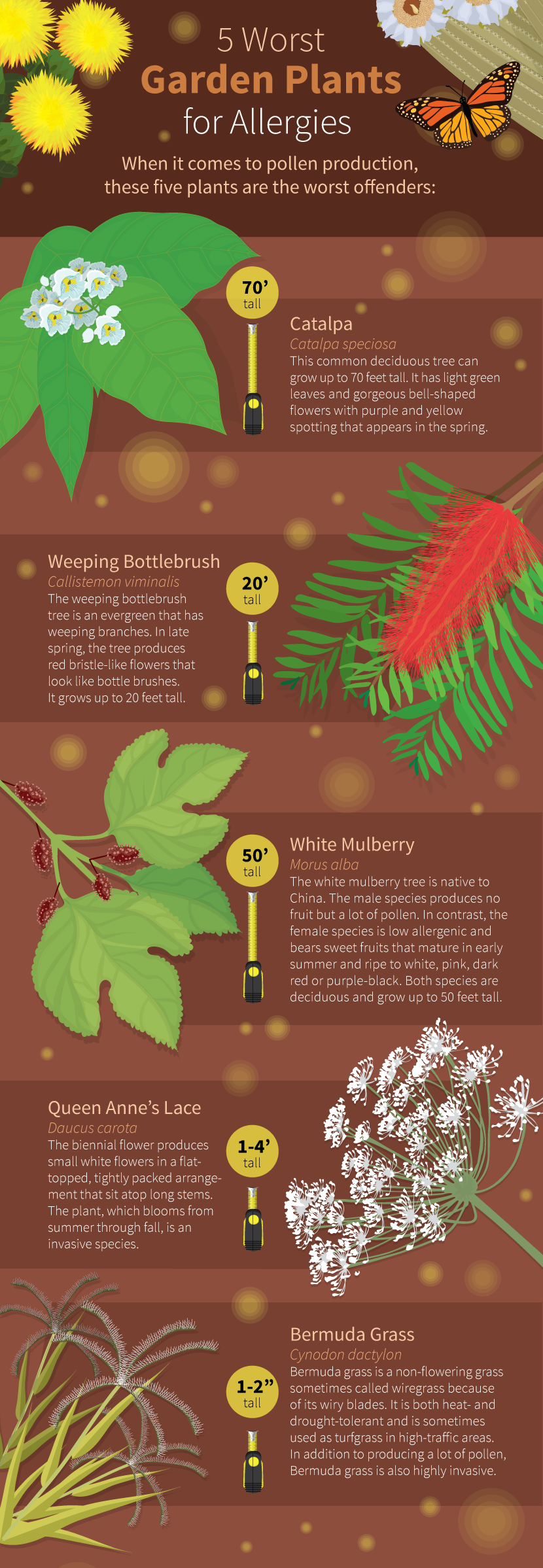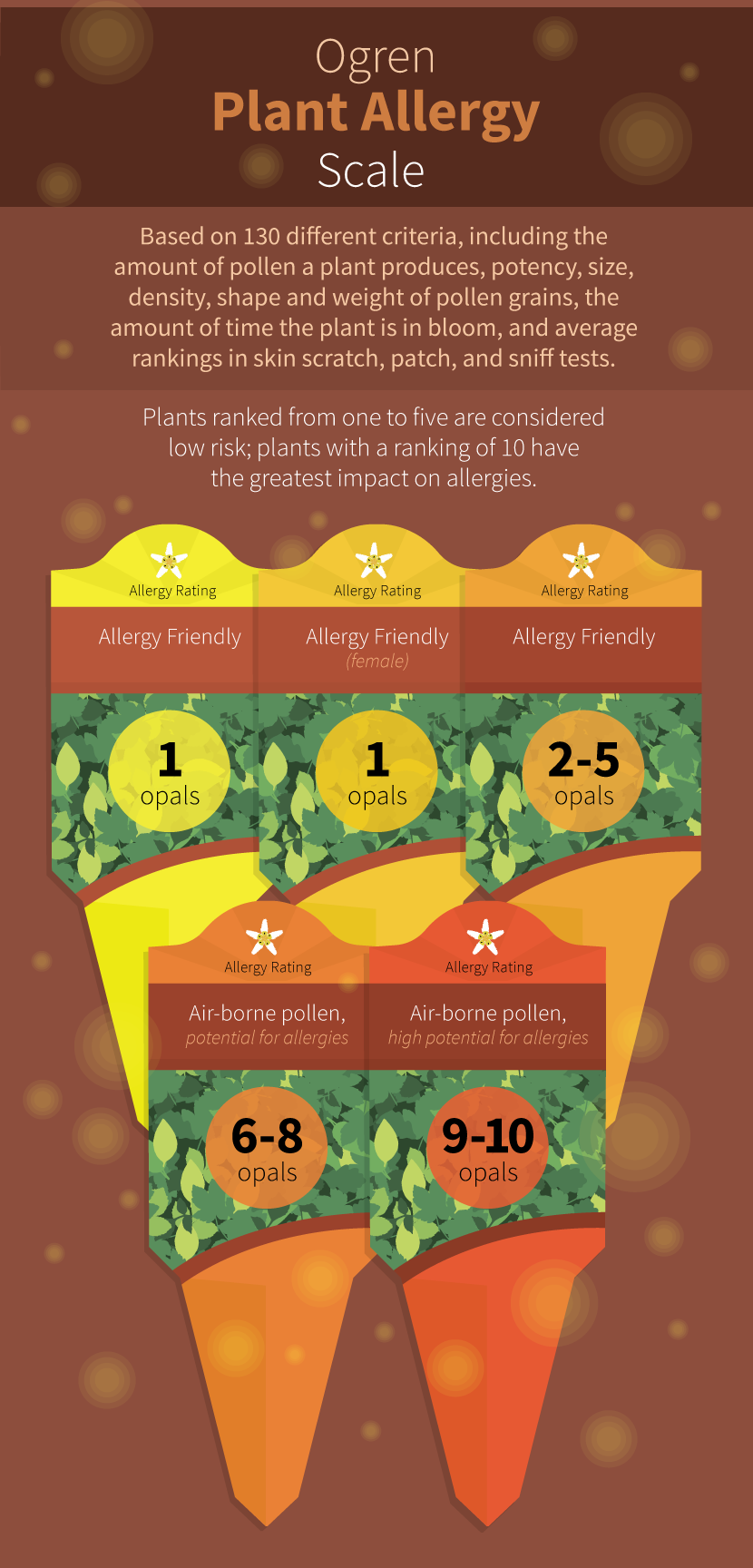Create a Sneeze-Free Garden
Allergy-Friendly Plants
If mowing the grass, trimming trees, and pulling weeds causes you to sniffle, sneeze, and have watery eyes, you’re not alone.
The pollen from trees, grass, and weeds are the most common allergy triggers, affecting more than 24 million Americans – and pollen counts appear to be getting worse.
Researchers at the Rutgers University Center for Environmental Prediction estimate that climate change will
increase pollen production from 8,455 grains of pollen per cubic meter in 2000 to 21,735 grains per cubic meter by 2040.
You don’t have to hide indoors during allergy season – you don’t even have to give up gardening.
A new area of research has uncovered the biggest culprits affecting pollen allergies.

Horticulturalist Thomas Ogren created a rating system called the Ogren Plant Allergy Scale
(OPALS) that assigns a rating from one to 10 to each plant based on its allergen level.
The OPALS is based on 130 different criteria, including the amount of pollen a plant produces; its potency, size, density, and shape;
the weight of the pollen grains; the amount of time the plant is in bloom;
and the plant’s average rankings in skin scratch, patch, and sniff tests. The higher the number, the more allergenic the plant.
Plants ranked from one to five are considered low risk;
plants with a ranking of 10 have the biggest impact on allergies;
these plants are known to trigger hay fever, asthma, and skin rashes.
The least-allergenic plants include female varieties of foxglove, hostas, blueberries, plum, impatiens, and snapdragons; these trees, shrubs, perennials, and annuals all have an OPALS rating of one.
Check out the OPALS ratings for common plants in Ogren’s book, Allergy-Free Gardening, to find low-allergenic options before shopping for trees, shrubs, and flowers for your garden.

Blame Botanical Sexism
In general, female plants – the species that produce fruit, seeds, and seedpods – are less allergenic than their male counterparts of the same species.
In urban areas, there are far more high-allergen male species. It’s a phenomenon known as botanical sexism.
Male species create less mess in public areas because there is no fruit, flowers, seeds or seedpods to clean up, making them favorites for landscape designers.
Because male species produce the highest levels of pollen, we have inadvertently created highly allergenic landscapes.
Even garden centers are stocked with an abundance of male species because growers have long been encouraged to use males for cuttings, grafting, and clones.
The Society for Allergy Friendly Environmental (SAFE) Gardening is encouraging garden centers to grow and sell varieties of trees, shrubs, and flowers that produce the lowest amounts of pollen.
To make it easier for the public to find these “SAFE” plants, the society is encouraging nurseries to get “SAFE” accreditations and OPALS certifications to nurseries.
Regional Efforts
Several cities have made efforts to reduce the amount of pollen in the environment by creating pollen control ordinances and banning specific varieties of trees.
Check out this map for more information on cities on the cutting edge of allergy-free zones.
Albuquerque, New Mexico: In 2004, this southwestern city created a pollen control ordinance.
It’s illegal to sell, import, or plant several species of trees and shrubs, including cypress, juniper, mulberry, and cottonwoods.
Clark County, Nevada: Olive and mulberry trees cannot be planted or sold in this Nevada county, which includes Las Vegas, under this ordinance.
Certain cultivars of low-pollinating fruitless mulberries and European olives are exempt from the ordinance.
Pima County, Arizona: In Arizona, Bermuda grass and olive and mulberry trees are banned because their pollens are known to cause allergies.
If Bermuda grass is in existing landscapes, it must be removed or it will be considered a nuisance under the ordinance.
Lobbying your local government to adopt pollen-control ordinances is one way to reduce allergenic plants. You can also have an impact by making changes in your own garden.

Choose low-allergenic plants: The American Academy of Allergy Asthma and Immunology recommends cacti,
cherry trees, dahlias, daisies, geraniums, hibiscuses, irises, magnolias, roses, snapdragons, and tulips as the best plants for allergy-friendly gardening.
Pull weeds: It’s not just trees, shrubs, and flowers that produce pollen; weeds can trigger allergies, too. Pulling weeds can remove additional pollen from your landscape.
Cut the grass: Keeping the grass cut prevents it from going to seed, which keeps pollen levels in check. Instead of letting it grow, mow it often.
Keep allergens outdoors: Storing your gardening gear, including gloves and shoes, in the garage, shed, or other outdoor location will prevent you from tracking pollen in the house.
If you suffer from seasonal allergies, shower and wash your clothing as soon as you’re done working in the garden.
Monitor pollen levels: The National Allergy Bureau sends email alerts about local pollen counts.
When the levels are high – even if your garden is filled with low-allergen plants – it’s a good idea to stay indoors.
You might not be able to remove all the pollen from the environment, but with a little extra attention to the plants you choose and your gardening habits, you can be sneeze-free in your garden.
Embed the article on your site

